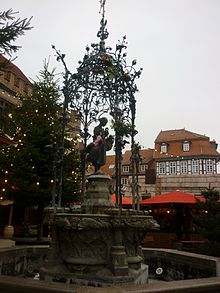Gänseliesel fountain (Göttingen)
The Gänseliesel-Brunnen is an ornamental fountain in front of the old town hall in the city center of Göttingen in Lower Saxony . The fountain with a goose as a fountain figure was built in 1901 and is a landmark of the university town. The fountain figure has been a copy since 1990, while the original figure is in the Municipal Museum .
history
The bronze figure of the fountain was created by the sculptor Paul Nisse based on a design by the architect Heinrich Stöckhardt . It depicts a young girl surrounded by several geese . For the redesign of the market fountain, the City of Göttingen's magistrate announced a competition as early as 1898, in which the jury awarded the second prize to the “goose girl” design. The design "In the spirit of the elderly / Tugendbrunnen" by K. Mehs and H. Jehs received the first prize. After the award ceremony, the population of Göttingen had the opportunity to give their opinion. Finally, after a long debate in the township, the figure of the goose girl was erected on June 8, 1901. An official inauguration never took place.
In 1968 the well system was completely renewed. The original fountain figure was replaced by a copy in 1990 and exhibited in the municipal museum .
Student custom
Parts of the student body soon included the well system in their customs. After their matriculation, the students climbed the fountain to kiss the fountain figure. Since this often happened in the context of noisy celebrations, an ordinance was issued on March 31, 1926, which made climbing the market fountain and kissing the goose-slipper punishable. Because the students did not adhere to it, there was a “kiss trial” in 1926. After the cand. Jur. Georg Graf Henckel von Donnersmarck was caught red-handed, he had to pay a fine of ten Reichsmarks (around 38 euros today). The law student challenged the fine and demanded from the court “freedom from kissing” and “to release the spell from the bronze lips”, but he was not successful either before the Göttingen district court or the Berlin higher court. The ban on kissing continued to apply officially, but was hardly observed. That is why the Gooseiesel is considered the most kissed girl in the world by the people of Göttingen. However, in the last few decades it was no longer the newly enrolled students who kissed the goose chick, but doctoral students after their successful exams. A bouquet of flowers is presented to the goose loaf. On the occasion of the 100th anniversary of the gooseiesel, the city council officially lifted the ban on kissing.
Gänseliesel as a regional symbol
Since 1995, once a year, a young woman has been elected “goose girl” on the initiative of a regional business association. It takes on representative tasks (especially in business development).
literature
- Günther Meinhardt: The history of the Göttinger Gänseliesel . Heinz Reise Verlag, Göttingen 1967
Web links
- https://denkmale.goettingen.de/brunnen/gaenselieselbrunnen.html. In: fountains - monuments - works of art. City of Göttingen, Culture Service, accessed on October 1, 2018 .
Individual evidence
- ↑ Inscription on the well
- ↑ Alexander Hüsing: Göttinger Gänseliesel: "Give you kiss freedom" , Spiegel Online June 6, 2001. Accessed November 28, 2008
- ↑ Antje Koolman, Sünne Jutrcenka: history of Mother Goose Fountain. In: Geschichtswerkstatt Göttingen eV / GöCam.de. Archived from the original on October 18, 2007 ; accessed on February 18, 2016 .
- ↑ The Göttinger Gänseliesel will be 110 years old goettinger-tageblatt.de, on June 6, 2011
- ↑ Custom remains despite the ban on kissing. (No longer available online.) In: 275 Years of Georgia Augusta. 2012, archived from the original on February 19, 2016 ; accessed on February 18, 2016 .
- ^ Preventive noise protection VG Göttingen, judgment of February 23, 2005 - 1 A 1214/02
Coordinates: 51 ° 31 '57.7 " N , 9 ° 56' 6.4" E


